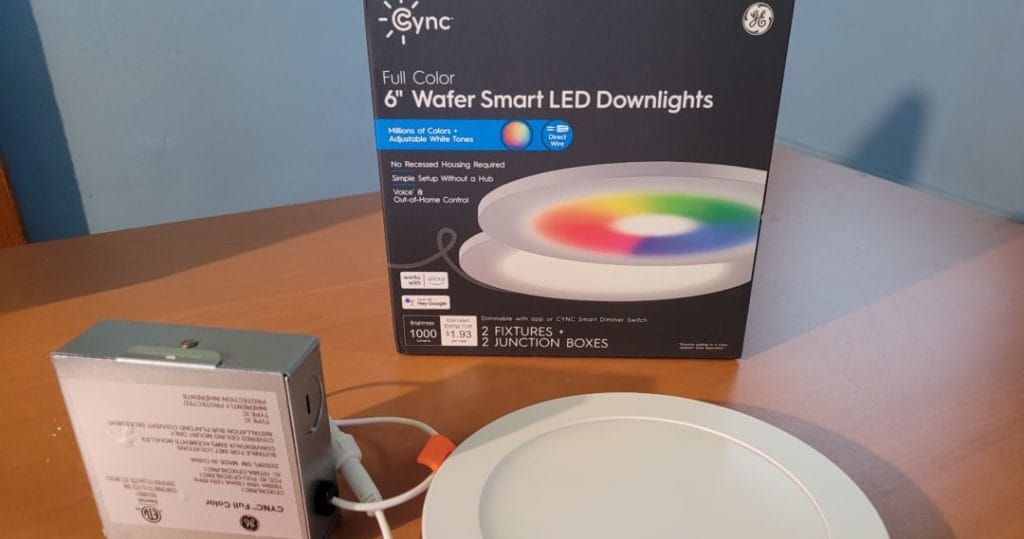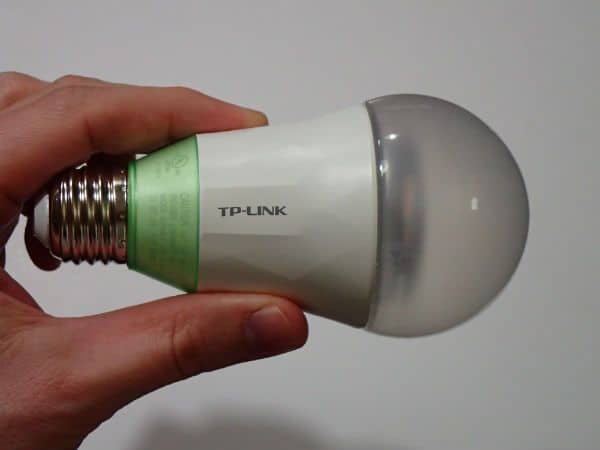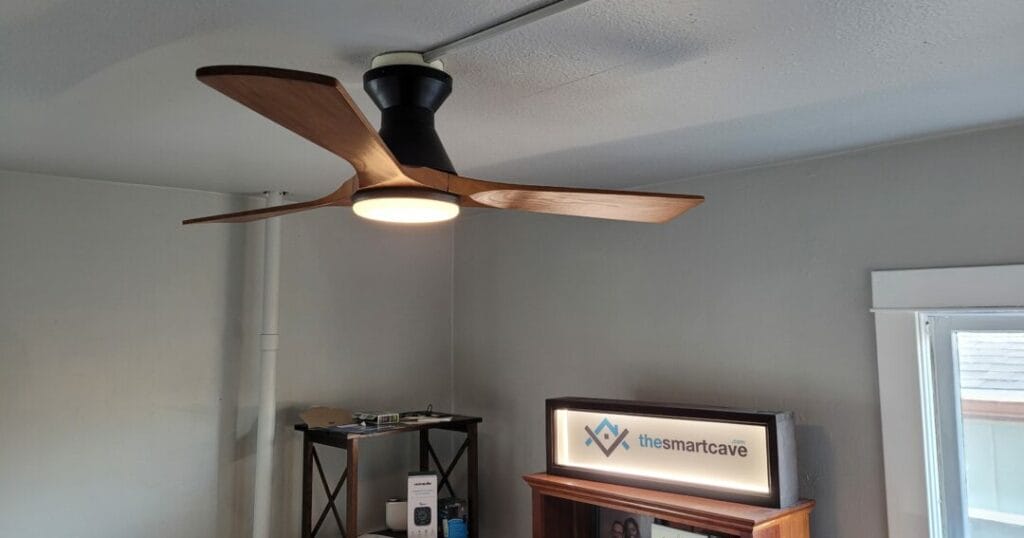If you want to upgrade your old recessed can lights to smart lights, or if you are looking to add some new smart recessed lighting, these are the lights you’re looking for. In this article, I’ll explain which models work best for each situation and which brands give you the best home automation experience.
Wafer Lights or Retrofit Can Lights?
First things first. Smart recessed lights usually come in two forms (see below). The form you want depends on your existing lighting situation.
Retrofit can lights– These smart lights are designed to fit inside existing recessed cans. They replace your old bulb and trim. They come in 2 common sizes: 4″ (fits 4″ cans) and 5″/6″ (adapts to fit either 5″ or 6″ cans). They typically have a height of 3″-4″. To get power, they usually come with an adapter plug that screws into the standard light socket inside the can. Then, the body of the light snaps into place inside the can using spring loaded clips.
Wafer lights (also called “canless” or “ultra-thin” LED lights) – These LED smart lights are shaped like a pancake. They commonly come in either 4″ or 6″ diameter, and are 1″-2″ thick. For power, they come with a metal junction box that gets wired into your home’s electrical wiring. Then, the LEDs connect to a low voltage wire that comes off the junction box. To install the light, you simply cut an appropriately sized hole in the drywall and spring clips hold the light firmly in place. The lights are so light-weight that no mounting fixture is necessary.
When to use retrofit recessed smart lights
If you already have recessed cans installed, then buying the retrofit smart LEDs will be the simplest way to upgrade your recessed lights to recessed smart lights.
When to use smart wafer lights
However, if you don’t already have cans installed, my preferred option is to go with the ultra-thin wafer style smart lights. Using the wafer lights eliminates the need to purchase and install any recessed can fixtures. They are also able to fit in significantly smaller spaces.
Best Retrofit: Philips Hue Smart Retrofit Recessed Downlight
| Preview | Product | Price | |
|---|---|---|---|

|
Philips Hue White & Color Ambiance 4-pack Smart Retrofit Recessed Downlights 5/6″ | 174.4 | Shop on Amazon |
In my experience, Philips Hue lights are some of the best smart lights available. The Philips Hue recessed retrofit lights are no exception. The lights have rich, accurate colors, and superb dimming ability. Plus, the Hue bridge provides a Zigbee connection that is fast and reliable.
High quality lights on a fast, reliable network are what most people talk about with Philips Hue, but one of the often overlooked factors is the ability to control the lights with a wall switch. With all Philips Hue lights, you have access to a bunch of smart switches that work directly with the lights. Most of these switches control on, off, and dimming. Some add the ability to recall scenes or cycle between color presets. And, a couple even have a full RGB color wheel to set your lights to any color you want right from the wall.
Currently, Philips Hue only offers the retrofit style recessed lights (no wafer lights), so you should have cans already installed in order to use these. They are available in 4″ and 5″/6″ sizes and can be purchased with full color (white and color ambiance) or tunable white (white ambiance).
The main drawback of the Philips Hue products has always been the price tag. In fact, one full-color Philips Hue recessed light is almost double the cost of a single full-color GE Cync light (see below).
However, it is possible to take advantage of the slick Philips Hue ecosystem without paying the sky-high prices for their lights. Since the Philips Hue system runs on Zigbee, you can actually connect any other brand of smart lights that run on Zigbee (needs to be Zigbee 3.0) to the Philips Hue hub. A lot of the “off-brands” are significantly cheaper than Philips Hue with only a minor reduction in performance (here’s my list of Philips Hue alternatives).
Best Wafer: GE Cync Wafer Smart LED Downlight
| Preview | Product | Price | |
|---|---|---|---|

|
GE CYNC Full Color 6″ Wafer Smart LED Downlights (Pack of 3) | Shop on Amazon |
Sometimes I feel like a broken record talking about the importance of being able to locally control your smart lights with a wall switch (remember above when I was gushing about Philips Hue’s ability to do this??). Nevertheless, it’s worth repeating: Direct control of a smart light using a smart switch is huge plus. It’s the main reason I think the Cync wafer lights deserve a spot at the top of this list.
The quality of the individual GE Cync lights is average. They get the job done. However, the GE Cync smart home system (read my full review) as a whole is definitely above average.
Cync devices use WiFi to connect directly to your home’s WiFi router, so you don’t need another bridge. In addition, the Cync devices are also equipped with BlueTooth. This allows Cync devices to connect directly to each other. This gives a Cync wall switch the ability to directly control Cync smart lights.
Cync devices can only “talk” directly to other Cync products. Therefore, the only smart switches that can control the lights directly are the GE Cync smart switches. I recommend the GE Cync Dimmer switch, or for integrated motion control, the GE Cync Dimmer + motion. The switches can control on/off and dimming, but they can’t control color. In order to do that, you’ll still have to either open the app or use your voice assistant.
Side Note: I love the versatility and reliability of the Philips Hue Zigbee lights. If they made a smart wafer light, they would most likely earn my number one ranking for wafer lights, too. However, they don’t make a smart wafer light. In fact, I haven’t been able to find a single smart wafer light that even uses Zigbee. If you know of some please let me know in the comments section!
Best for Accent Lighting: Lumary Smart Recessed Slim LED Panel Light
| Preview | Product | Price | |
|---|---|---|---|

|
Lumary 6″ Ultra-Thin Smart Downlight (4 pack) | 136.99 | Shop on Amazon |
A few months back, I purchased some of these Lumary ultra-thin smart lights. The main reason I wanted the Lumary lights was for the ultra-thin form factor (LED wafer). The light is less than 2 inches thick, so like other wafer lights, it’s ideal for installing where space is limited.
The Lumary lights have good quality colors with decent dimming capabilities. They use RGBWW LEDs which help to create accurate whites as well as rich colors. At full power they are quite bright with 1100 Lumens, but use only 13 Watts. As far as I can tell, these are some of the highest quality recessed smart lights in this price range.
Lumary has their own app which you can use to configure your lights. It’s very much like the Tuya Smart Life app. Alternatively, you can actually use the Tuya Smart Life app instead of the Lumary app.
I use Alexa to control the lights 95% of the time, and it works well. But…
One of my biggest pet peeves is a smart light that DOESN’T work with smart wall switches. Unfortunately, the Lumary lights fall into this category. The lack of ability to easily control with a wall switch makes me shy away from recommending these lights as the main lights for a given room. However, if you want to use them as accent lights, they should work just fine.
Other Tuya Smart Life recessed smart lights
If you do a search for “smart recessed lights” on Amazon, you will find a bunch of listings for WiFi lights that use the Tuya Smart Life platform. It seems like new brands pop up and old ones disappear all the time. To me, it appears that they are all selling basically the same hardware, and just slap their own brand name on it. I know they’re not all exactly the same, but they’re similar enough that the differences in hardware hardly matter.
The main thing to take note of is that they all use WiFi and they all connect through the Tuya Smart Life app. Therefore, they all suffer the same lack-of-wall-switch control problem as Lumary.
Nevertheless, if you don’t care about the wall switch (or you are able to hack your way around it), there are some really good prices on full-color smart recessed lights. Here are some of the most popular brands I have researched (I haven’t personally used them):
Smart recessed lights still too expensive? Use a smart switch instead
In most recessed lighting situations, you will have multiple lights in a single room. You might have 4, 6, 12, or even more lights in one room. If you are going to replace all those lights with smart lights, the cost can add up in a hurry. Therefore, if you’re looking for a more economical option, you might consider using non-smart recessed lights (like these)** and then controlling them with a single smart switch or smart dimmer. If you decide to go this route, I highly recommend the Lutron Caseta dimmers. They’re extremely reliable and have great dimming performance even with LEDs (here’s my full Lutron Caseta review).
With the smart switch/dimmer option, you can still control your lights with voice control and home automation routines (as well as using the wall switch). However, the drawbacks are that you will lose the full-color capabilities of smart lights and the ability to individually control each light. Read more about smart lights vs smart switches.
**NOTE: Don’t be fooled by these 5 CCT models. They are NOT smart lights. They do have adjustable white color temperature, but changing between colors is not a quick process. For a smart light, you expect to be able to use an app or voice to quickly change the color or color temperature. With these models, it is a physical switch. And, the physical switch is located on the junction box which is typically hidden inside your walls. Changing the setting of the switch requires removing the light from its recessed cavity so that you can access the junction box.
Final Thoughts
To me, the starting point for a good quality smart light needs to be a great system that controls it.
If you get a great deal on a smart light, but every time you want to use it, you have to pull out your phone and open an app, it’s NOT going to get used. After all, the whole purpose of smart home and smart lighting is to make our homes more inviting, relaxing, and easier to use.
For that reason, the Philips Hue recessed lights and GE Cync recessed lights are the current clear leaders for smart recessed lighting. Brands like Lumary still have their place, but until they can integrate direct control from wall switches, they will continue to be in 2nd place as far as I’m concerned.



![CLOUDY BAY [6 Pack] 6inch Smart WiFi LED Recessed Lights,RGBCW Color Changing Recessed Lighting,Compatible with Alexa and Google Home Assistant,No Hub Required,15W 2700K-6500K,CRI90+ Wet Location](https://m.media-amazon.com/images/I/41H5465vC2L._SL160_.jpg)






